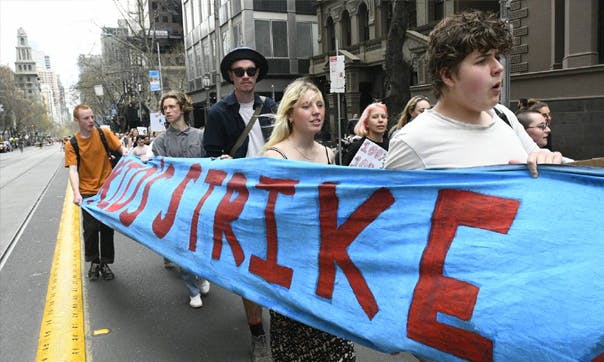What the climate strike means

When protests are big enough, they can change people’s lives. The climate strikes in Australia were some of the first to take place on the world’s day of action. Once they were finished, we watched reports of the millions who joined us around the world. Before 20 September, those millions shared a sense of urgency about an impending climate disaster. Now we all share something else: the knowledge that if we act together, we can shut down cities all over the world. What do we do with that knowledge?
When the streets fill with protesters, some of the rules of daily life are suspended. Protesters climbed on roofs and monuments, singing and chanting. They did it to get a better view of the enormous crowds and to hang signs and banners – but also because, when that many people have taken over the city, you can climb wherever you like, and why not take advantage of it? Protests of such a scale give us all a glimpse of the power we have to change the way society works if we act together.
And never doubt the importance of small protests. The movement’s initiator, Greta Thunberg, first took to the streets by herself. If any would-be activists wonder whether there’s any point in going out on a limb when you’re politically isolated, they should remember how her leadership ignited a global movement of millions.
That leadership came when the climate crisis has become impossible to ignore – for those of us who aren’t so rich that we can evade its worst consequences. The breaking of temperature records, the unleashing of new feedback loops and the identification of more potentially irreversible tipping points have shaped the consciousness of a generation. Capitalism has created a crisis of such terrifying scale that millions around the world were ready to respond to the determined lead of Greta Thunberg and her growing bands of supporters.
Reflecting on the size of the protests, Tim Flannery of the Climate Council said: “We’re finally gaining the critical mass where government can’t ignore this message any longer”. But that misses the point. The government – and the ruling class – have ignored the message from scientists, and they’ve ignored it from polls that show overwhelming support for action on climate change. They don’t need to be woken up; they are wide awake. They know their actions endanger the planet. They know we don’t like it. And they don’t care.
We shouldn’t attend protests like the climate strike in the hope of awakening the government’s conscience. Scott Morrison is a dedicated pro-coal activist who lives to serve big business. His job is to stop us from getting our way. A mass protest shows us the power that exists on our side. That knowledge is for us to use. Hundreds of thousands in major cities, and thousands elsewhere, are willing – here in Australia, where coal is said to be so vital to the capitalist economy – to spend the day in the streets. By doing so, we transformed the cities. Now we all know we can do that. What else can we do to save the world?
In the build-up to the protest, the momentum was so intense – and the march’s aims limited enough – that businesses got on board. Consultancy firms took out ads offering to help companies get involved. A coalition of businesses supporting the event was founded – “Not Business As Usual”. That might have boosted the size by encouraging more bosses to allow their workers to walk out without penalty.
But the “businesses community” – the capitalists whose economic system is responsible for the impending disaster – will never give permission for the kind of actions this movement will need if it’s going to win. We need to disrupt the cities not just once, twice or three times a year. We need protests and actions in schools, university campuses and workplaces. We need to walk out when we don’t get permission. We need to do whatever we can to disrupt the system that threatens our survival.
Mass demonstrations are an indispensable part of such a movement. More will be necessary. They show us the forces on our side; they bring new people into the fray and inspire them with our manifest ability to change the world when we’re all fighting side by side; they measure the growth of our movement. Each mass demonstration can leave a legacy: hundreds or thousands of new activists, who don’t just go home and wait for the next protest, but begin to get organised.
If just a fraction of the attendees at the climate strike organise in an ongoing way to fight the powerful, disrupt the system and defy their bosses – even those nice ones who support one or two peaceful marches a year – it would stun those who are responsible for the carbon pollution that threatens us all. Polls can be ignored by the powerful. Science can be ignored. The occasional protest march can also be ignored – unless they galvanise us into an ongoing fight against the system.
Our task isn’t to change the minds of the powerful. It’s to build our own power, from the bottom up. After the climate strike, that means organising and promoting every act of disruption, rebellion and resistance we can. By believing in each other, organising ourselves and challenging the powerful, we can begin to lay the basis for a new type of society.